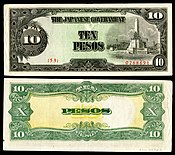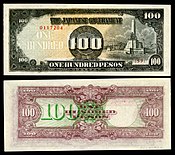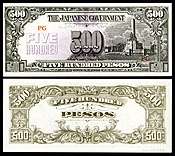
The Philippine peso, also referred to by its Filipino name piso, is the official currency of the Philippines. It is subdivided into 100 sentimo, also called centavos.

Banknotes of the Philippine peso are issued by the Bangko Sentral ng Pilipinas for circulation in the Philippines. The smallest amount of legal tender in wide circulation is ₱20 and the largest is ₱1000. The front side of each banknote features prominent people along with buildings, and events in the country's history while the reverse side depicts landmarks and animals.

Philippine peso coins are issued by the Bangko Sentral ng Pilipinas for circulation in the Philippines and are currently available in seven denominations. The Philippine peso has been in use since Spanish rule.

Emergency circulating notes were currency printed by the Philippine Commonwealth Government in exile during World War II. These "guerrilla pesos" were printed by local government units and banks using crude inks and materials. Due to the inferior quality of these bills, they were easily mutilated.

Japanese invasion money, officially known as Southern Development Bank Notes, was currency issued by the Japanese Military Authority, as a replacement for local currency after the conquest of colonies and other states in World War II.
The New Design Series (NDS) (also known as the BSP Series after the establishment of the Bangko Sentral ng Pilipinas) was the name used to refer to the banknotes of the Philippine peso conceptualized from 1983 to 1985, issued from 1985 to 2013 and circulated from 1985 to 2019 including commemorative notes, and coins issued from 1995 to 2017. The coins were minted and issued from c. December 1995 to November 30, 2017, and remain legal tender as of 2023. It was succeeded by the New Generation Currency (NGC) Series that was conceptualized from 2007 to 2010, and issued on December 16, 2010 for banknotes and November 30, 2017 for coins. The series used the Friz Quadrata, Arial, Optima, and Helvetica typeface.
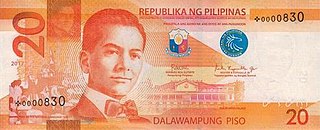
The Philippine twenty-peso note (₱20) is a denomination of Philippine currency. It is the smallest banknote denomination in general circulation in the Philippines. Philippine president Manuel L. Quezon is currently featured on the front side of the note, while the Banaue Rice Terraces and the Asian palm civet is featured on the reverse side.

The Philippine fifty-peso note (₱50) is a denomination of Philippine currency. Philippine president and former House Speaker Sergio Osmeña is currently featured on the front side of the bill, while the Taal Lake and the giant trevally are featured on the reverse side.

The Philippine one hundred-peso note (₱100) is a denomination of Philippine currency. Philippine president Manuel A. Roxas is currently featured on the front side of the bill, while the Mayon Volcano and the whale shark are featured on the reverse side.

The Philippine two hundred-peso note is a denomination of Philippine currency. President Diosdado Macapagal is currently featured on the front side of the note, and since 2017, President Gloria Macapagal Arroyo's inauguration as the 14th President of the Philippines is on the lower-left side on the note just in front of the scene of the Declaration of Philippine Independence, and the scene of the opening of the Malolos Congress is also present on the obverse side of the note. From 2010 to 2017, the Aguinaldo Shrine and the Barasoain Church were featured on the front side of the note. The Chocolate Hills and the Philippine tarsier is featured on the reverse side. Currently, it is the rarest banknote circulating in the country, and thus is seen more as a novelty than legal tender.

The Philippine five hundred-peso note (₱500) is a denomination of Philippine currency. President Corazon Aquino and her husband, Senator Benigno Aquino Jr. are currently featured on the front side of the note, while the Puerto Princesa Subterranean River National Park and the blue-naped parrot are featured on the reverse side.

The Philippine one thousand-peso note is a denomination of Philippine currency. It is the largest denomination in general circulation in the Philippines. It is currently the only Philippine peso denomination that has a polymer banknote version.

The Philippine five-peso coin (₱5) is the third-largest denomination of the coins of the Philippine peso.

The Philippine ten-peso note (₱10) was a denomination of Philippine currency. In its latest incarnation, Apolinario Mabini and Andrés Bonifacio are featured on the front side of the notes, while the Barasoain Church and a Blood Compact scene of the Katipuneros are featured on the reverse side. This banknote was circulated until the demonetization of main banknotes under the New Design Series on January 3, 2018. Its printing was stopped in 2001 and was replaced by coins.

The Philippine five-peso note (₱5) was a denomination of Philippine currency. Philippine president Emilio Aguinaldo is featured on the front side of the note, while the Declaration of the Philippine Independence is featured on the reverse side. This banknote was circulated until the demonetization of main banknotes under the New Design Series on January 3, 2018. Its printing was stopped in 1995 and was replaced by coins.
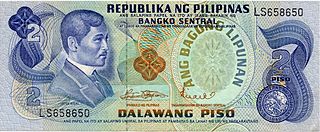
The Philippine two-peso note (₱2) was a denomination of Philippine currency. On its final release, José Rizal was featured on the front side of the bill, while the Declaration of the Philippine Independence was featured on the reverse side.
The Ang Bagong Lipunan Series is the name used to refer to Philippine banknotes and coins issued by the Central Bank of the Philippines from 1973 to 1985. It was succeeded by the New Design series of banknotes. The lowest denomination of the series is 2-piso and the highest is 100-piso.
The history of Philippine money covers currency in use before the Hispanic era with gold Piloncitos and other commodities in circulation, as well as the adoption of the peso during the Hispanic era and afterwards.
The New Generation Currency (NGC) Series is the name used to refer to the Philippine peso currency series conceptualized from 2007 to 2010, and banknotes issued since 2010 and coins issued since 2017. The series uses the Myriad and Twentieth Century typefaces.

The Philippine fifty-centavo coin (50¢) was a denomination of Philippine currency. It was minted for the Philippines from 1864 to 1994 and was demonetized in 1998.











